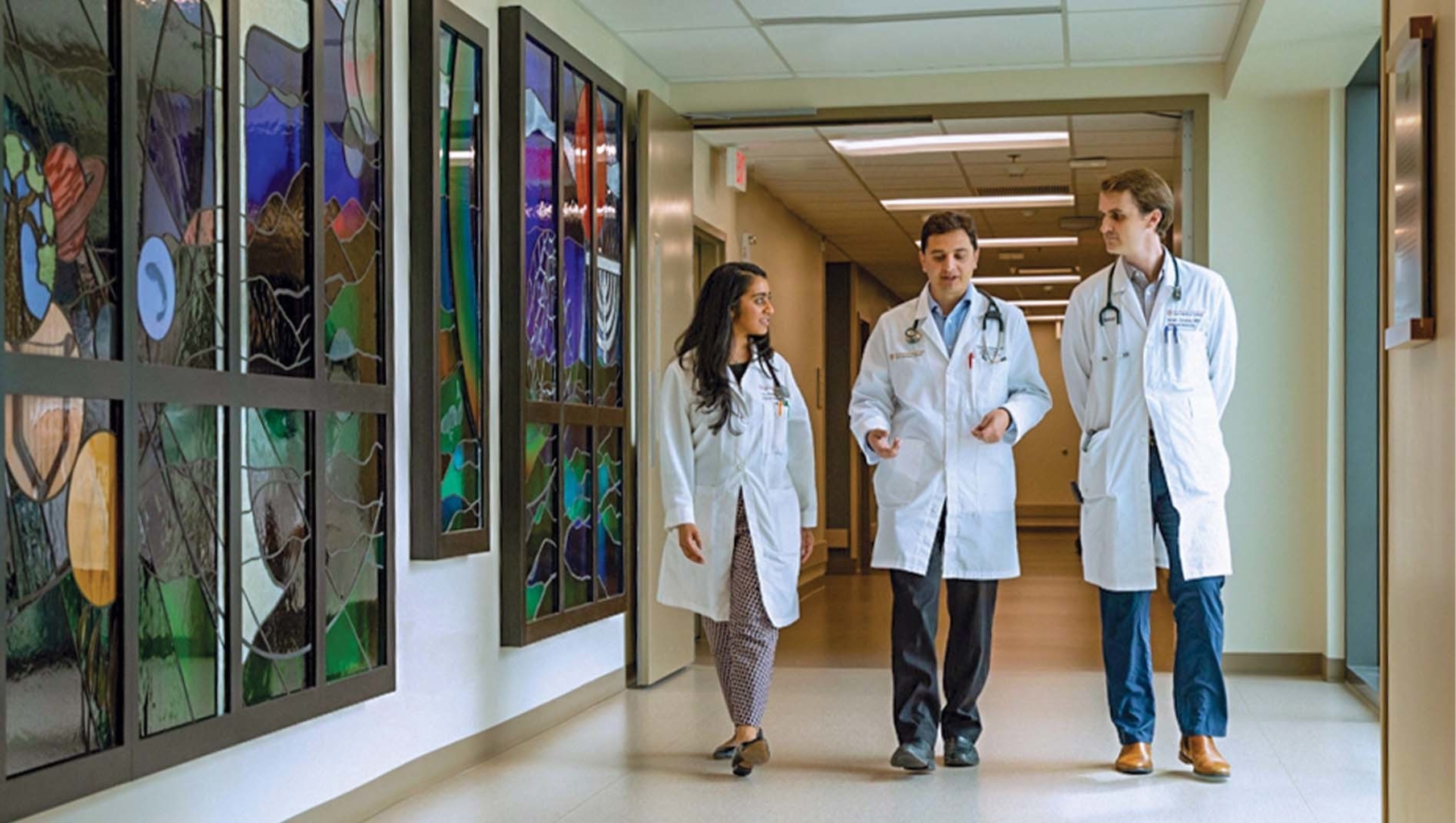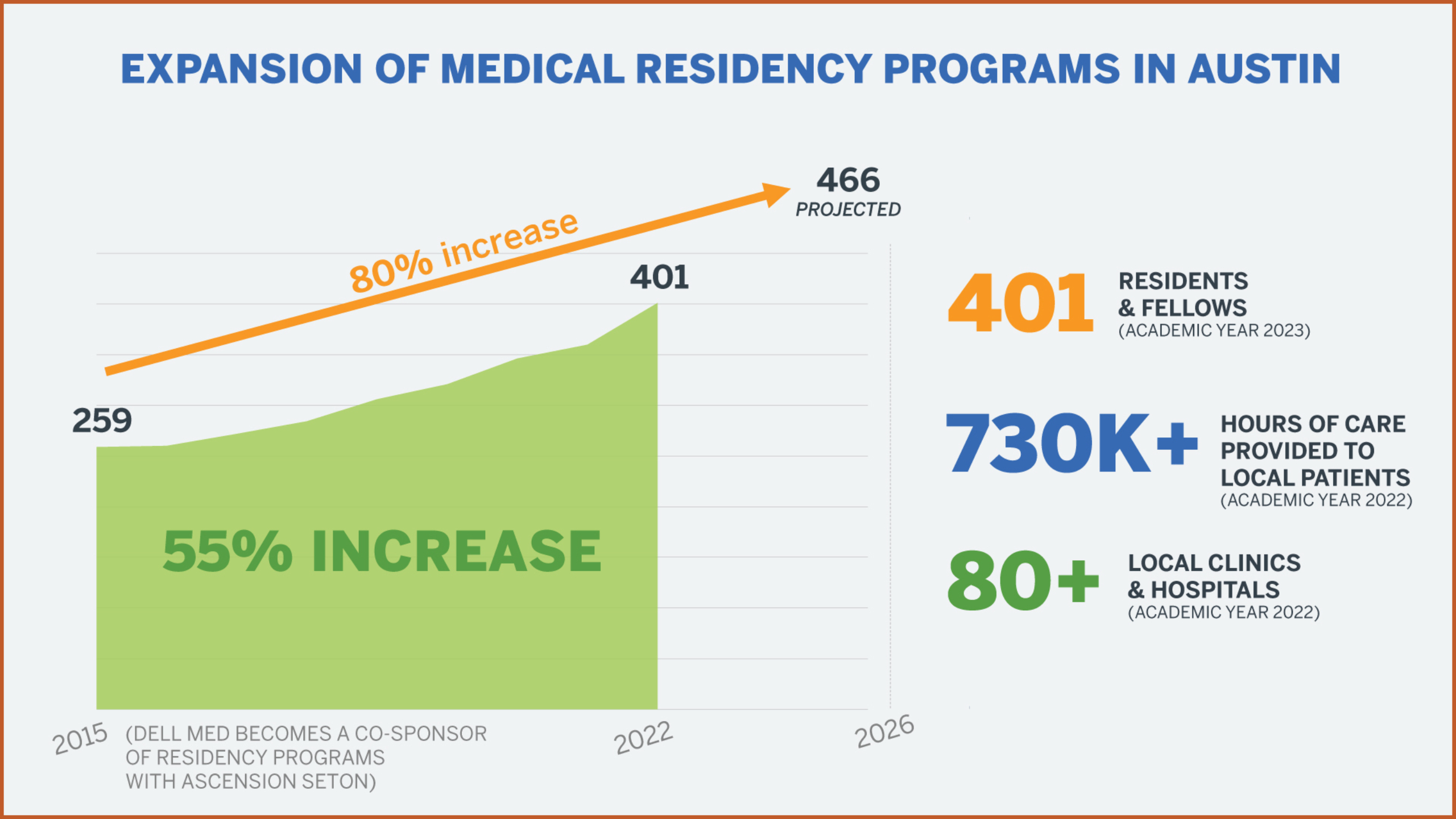Expansion to 401 doctors in graduate medical education training marks a 55% increase in seven years.

AUSTIN, Texas – The number of medical residents and fellows in Travis County affiliated with Ascension Seton and Dell Medical School at The University of Texas at Austin has risen 55% since 2015. This translates to 401 new doctors providing specialty care for Central Texas patients, including tens of thousands of uninsured and underinsured patients each year, in collaboration with community partners.
The increase is tied to expanding the number of Graduate Medical Education (GME) training programs – up from 15 in 2015 to 46 today. As these programs mature, the number of residents and fellows is projected to rise to 466 by 2026 – an 80% increase since 2015. New programs include identified areas of local need such as ophthalmology, neurology, gastroenterology and addiction psychiatry.

Between 2015 and 2022, the number of Dell Med residents and fellows has risen from 259 to 401, a 55% increase. As programs continue to grow, the total number of trainees is expected to increase to 466 by 2026, an 80% increase. In the 2022 academic year, residents and fellows provided over 730,000 hours of care to local patients in more than 80 Central Texas clinics and hospitals.
“Particularly in the context of Austin’s rapidly growing population and a doctor shortage that’s projected to worsen, residents and fellows are a very significant health care resource for Travis County patients and families, particularly for those most in need,” said George Macones, M.D., Dell Med interim dean and professor in the Department of Women’s Health. “They are also an essential part of Dell Med’s mission-focused team.”
In 2015, Ascension Seton collaborated with the newly launched medical school to expand its existing graduate medical education programs and openings, with Dell Med serving as the sponsoring institution. Prior to that, UT Southwestern Medical Center in Dallas was the academic partner for Ascension Seton.
“Ascension Seton knows the importance of educating the future physicians of Central Texas,” said Andy Davis, president and CEO of Ascension Texas. “Through our affiliation with Dell Medical School, Ascension Seton invests more than $50 million a year in graduate medical education, which has allowed us to grow new and existing programs together. This work helps us provide quality care and extend our mission, with a focus on individuals who are vulnerable or experiencing poverty.”
These 401 residents and fellows employed by Ascension Seton are in addition to the 415 physicians who have relocated to Austin since 2014 to join the Dell Med faculty, according to a recent news release.
Medical Residents & Fellows: A Vital Community Health Resource
Residents are medical school graduates pursuing three to seven years of postgraduate training in a medical specialty. Fellows are doctors who pursue at least one more year of subspecialty after completing a residency program. Both residents and fellows provide care under supervision of medical school faculty members.
Among the program’s community partners are Central Health-affiliated CommUnityCare Health Centers and the Central Texas Veterans Health Care System and its Austin outpatient clinic, with both recognizing the value that residents and fellows provide.
“At CommUnityCare, we build residents and fellows into our daily health transformation work to not only expand the impact our health centers have on our communities’ well-being,” said Nicholas Yagoda, M.D., chief medical officer at CommUnityCare, “but also to grow a future health care workforce focused on health equity and population health.”
“The VA continues to host residents and fellows as they further their training in internal medicine and primary care, as well as in specialties such as dermatology, psychiatry, hospice/palliative care and neurology, among others. The partnership has proved to be an overwhelming success for trainees, the VA and veterans alike,” said Pawan Sikka, M.D., associate chief of staff for education at the Central Texas Veterans Health Care System.
When you talk about a ‘healthy city,’ it means that every citizen of the community should have easy access to a higher level of specialized care, and it felt good to be a part of that for Austin.
Blessing Oyeniyi, M.D.
Some specific examples of local care provided by residents and fellows, including for uninsured and underinsured patients:
- In academic year 2022 alone, they provided more than 730,000 hours of care at more than 80 Central Texas clinics and hospitals operated by clinical partners Ascension Seton, CommUnityCare, Central Texas Veterans Health Care System, People’s Community Clinic, Lone Star Circle of Care, Integral Care, and others.
- Based on annualized data from 2021, they provided care to approximately 12,000 patients at CommUnityCare during approximately 20,000 patient visits. CommUnityCare is the largest safety-net provider of primary care health services in Travis County.
- At three local Ascension Seton hospitals – Dell Seton Medical Center, Ascension Seton Medical Center Austin and Dell Children’s Medical Center – they provided care as part of nearly 150,000 patient visits during academic year 2022, marking a 322% increase in resident-related patient visits since 2019. This data does not include care provided at Ascension Seton Shoal Creek.
Dell Med leaders also point to the important role residents and fellows have played in the local collaborative response to the COVID-19 pandemic. For example, they joined Dell Med faculty members and teams at Dell Seton Medical Center to create nationally recognized COVID-19 Centers of Excellence at the hospital. The result: mortality rates were 33% lower than the national average for COVID-19 patients with medical complexities. By March 2021, at least 75 more people had survived than would have been expected based on national averages.
One recent residency graduate is Blessing Oyeniyi, M.D., who completed her four-year psychiatry training at Ascension Seton Shoal Creek for behavioral health and at the inpatient psychiatry unit and emergency psychiatry department at Dell Seton Medical Center.
“I took care of medically underserved patients every day in residency. That experience helped me grow in my empathy toward others, and I learned to care for people from all different circumstances and backgrounds,” Oyeniyi said.
“When you talk about a ‘healthy city,’ it means that every citizen of the community should have easy access to a higher level of specialized care, and it felt good to be a part of that for Austin.”
Increasingly, local residents and fellows are reflecting the communities they care for, though there’s still more work to be done in this area, said Macones. A residency demographics report shows that among the 401 residents and fellows, 21% identify with a race or ethnicity underrepresented in medicine, as defined by the Association of American Medical Colleges.
That’s compared with a U.S. average of 13.8%.
Residents Often Stay Where They Train
Data shows that residents tend to stay to practice in the states where they train. Of the program’s 664 residency and fellowship graduates since 2015, 232 opted to pursue additional training and 432 immediately entered practice. Of those immediately entering practice, 45% (194) are now practicing in Central Texas and 71% are practicing in Texas (compared with a 57% national average).
Among the differentiators attracting new medical school graduates to Austin is the signature Advancing Care Transformation, or ACT, curriculum focused on health systems science. The program prepares residents to identify and address systemic challenges in health, and to lead change in an evolving health care landscape. More information on the ACT curriculum is available in this video.